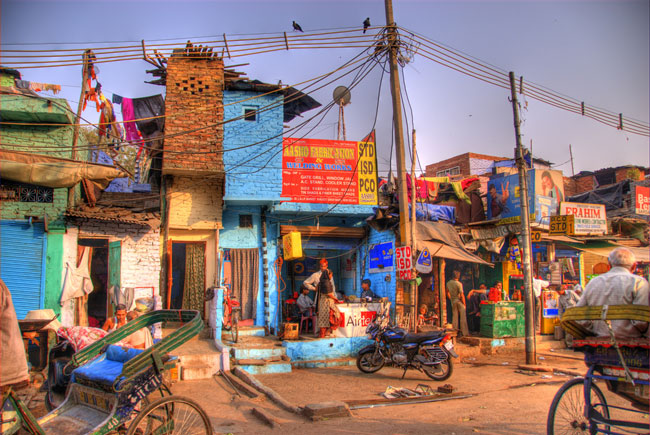

The pedal-powered rickshaw puller rammed on the hand brakes as he collided with the motorized tuk-tuk directly in front of us.
The screeching noise added to the beeps, honks and shouts rising from the symphony of an Old Delhi traffic jam.
I looked behind through the open space of our perch and with wide eyes and gaping mouth waited for a similar impact from a scooter closing the gap.
Exploring Old Delhi by Rickshaw
I heard the spokes of the bicycle’s front tire scraping against the struts of the carriage trying to pass us on the right. A quick purse snatch from the woman riding in the rickshaw alongside ours would be kid’s play.
Realizing that she could just as easily lift my wallet, I pressed my handbag into the center crease of the seat. Tucking both elbows snuggly inside the arm rail, I wound my camera strap so tightly around my wrist that veins bulged.
Delivery vans, push carts, cars and contraptions of boards and plastic wired together fought for every inch of narrow road space.
Weaving and bobbing through this virtual sea of vehicles, merchants teetering under the weight of bales of fabric atop their heads, snaked across the street.
A bump here, a thud there, none of the rickshaw pullers, called lakhs, even flinched at the barrage of assaults.
A stray cow sauntering in the opposite direction of the traffic seemed to instinctively know that drivers would rather collide with another vehicle than crash into the animal’s ‘sacred’ hide.
Human life didn’t appear to rank quite so high.
Our young, lean cyclist crawled forward unfazed by the organized chaos. He pressed his worn thin flip-flops down on the pedals. A teenager’s day in Old Delhi; riding a bicycle in flimsy footwear, pulling a carriage with two Western travelers.
True to the universal distraction he balanced the handlebars with one finger and grabbed his cellphone from his back pocket, checking for messages. Staying connected appeared to take priority over safety in India as well.
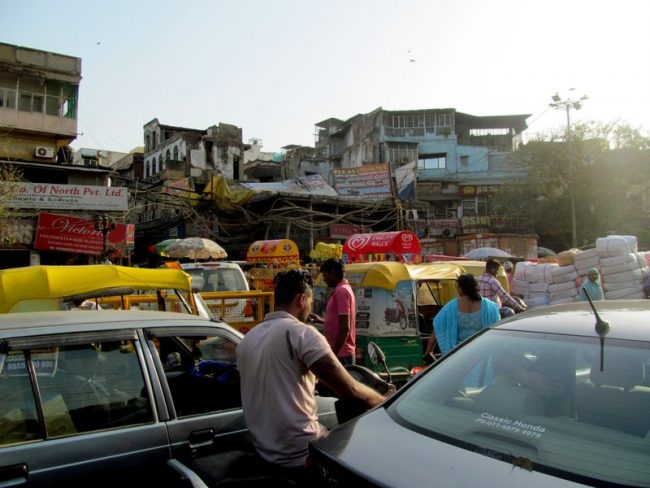
Chandni Chowk in Old Delhi
Chandni Chowk Bazaar, the busiest market in Old Delhi, was built in the mid-17th century by Moghul Emperor Shah Jahan and designed by his daughter Jahanara.
The market’s name, derived from the Hindi word meaning silver, related to the sale of items crafted from this precious metal.
A reflection pool originally constructed in the center of the shopping area had once shimmered in the moonlight. For centuries, this commerce mecca retained the nickname of Silver and Moonlight Square.
The silver market has thrived for over three hundred years but the small canals and the pool were filled in with more stores and narrow alleys.
Just outside the walls of India’s largest mosque, Jama Masjid built around the same time as the market in 1650 and located on the outer fringe of the bazaar, numerous rickshaws lined the street.
Each one had its own unique characteristic and eager lakhs used high pressure tactics or charming teenage innocence to entice worshippers or shoppers into their carriages.
The prospect of earning rupees for every jaunt must make pulling a cart full of people and goods through the masses less grueling.
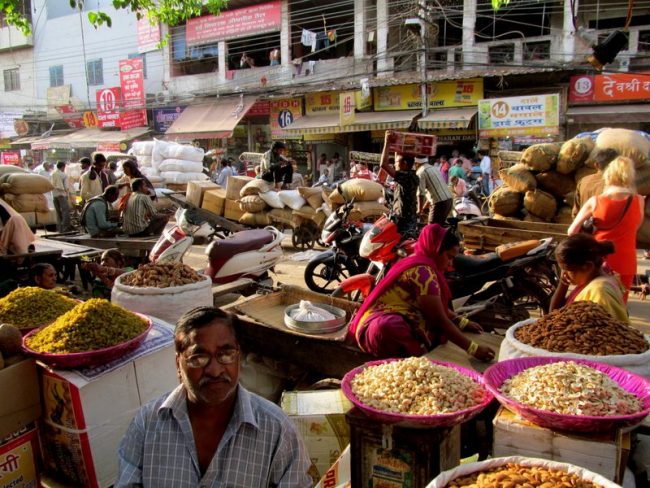
Today Chandni Chowk is rated as having the greatest number of cycle rickshaws in the world and their use has made a significant reduction in India’s serious air pollution problem.
Utilizing only human power, pedal rickshaws save the cost of constructing parking areas for cars and trucks, and provide a low-cost alternative for transporting household goods around the market area.
Often instead of people, these bicycle carts carry bales of cotton, sacks of rice or crates of fruits and nuts.
A benefit to the labor force issues, lakhs earn a decent wage without being a drain on the government for support. The push is on to ban all motorized vehicles throughout the Chandni market area.
Journey in the Rickshaw
An hour earlier, we had picked a rickshaw with a red plastic seat repaired with black electrical tape and topped with a tasseled, blue tarp roof to protect from the brutal Delhi sun.
A 15-year-old named Alok won me over with his curly black hair and alluring smile. He offered me a banana as he held my hand and steadied the cart while I climbed into the narrow, uncomfortable space.
We started off at a moderate clip and the slight breeze through the open-air gig brought relief from the stifling 115 degree afternoon heat. Bliss would be short-lived.
We turned the corner onto the main market street and became snared in the traffic snarl. The first 50 meters had been a tease. Nothing to do but sit back, munch on my banana and take it all in.
The Busy Market
The jammed market area and constant grind of activity has been called a living museum. It stimulated all my senses. Merchants standing in the doorways of their narrow shops barked their sales pitches in Hindi.
Women in colorful silk saris, loaded down with vegetables and other market goods, sloshed through the trash that piled up ankle deep along every curb.
Clumps of tangled electrical wires overhead formed grotesque shapes mid-air, then somehow braced themselves against the buildings.
Rice bags brimming with turmeric, cumin and curry hogged valuable sidewalk space and robust spice aromas wafted into the air.
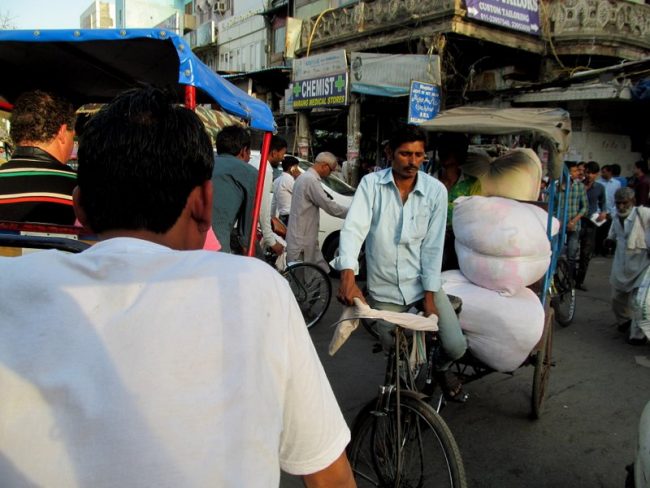
I clenched my banana peel tightly determined that I would not add to the garbage strewn everywhere.
Delhi has attempted to put trash cans around the city, but these receptacles remain in place only a few hours before they are stolen to be sold in the market for other uses.
I could never comprehend this habit, visible throughout India, of discarding items on the spot. We saw city streets, highway shoulders and fields in the countryside littered with unwanted items.
A rare Dumpster overflowed and cows crowded around it looking for dinner. The sight of bony, malnourished cattle, sorting through garbage for their food made me look away.
I guarded that banana peel for over an hour, but then our young pedal-pusher stopped at the spice market to let us browse in the shops for 10 minutes. He gently uncurled my fingers wrapped around the peel and said, “Madam, give to me.”
I knew its fate the moment he took it. It joined the heap of trash at his feet. My determined effort to be one person out of 1.2 billion who didn’t litter − dashed.
A leisurely stroll through the market proved impossible. Waves of humanity rolled along and anyone who stood still got trapped in the movement of the masses.
The sidewalk resembled an obstacle course as I stumbled along. Homeless vagrants curled up in the doorways, merchants selling fruit in the middle of the walkway and small crevices waiting to snag an unsure foot were three impediments that sent me reeling.
I raced back to the comfy protection of our waiting rickshaw. Walking turned out to be riskier than riding.
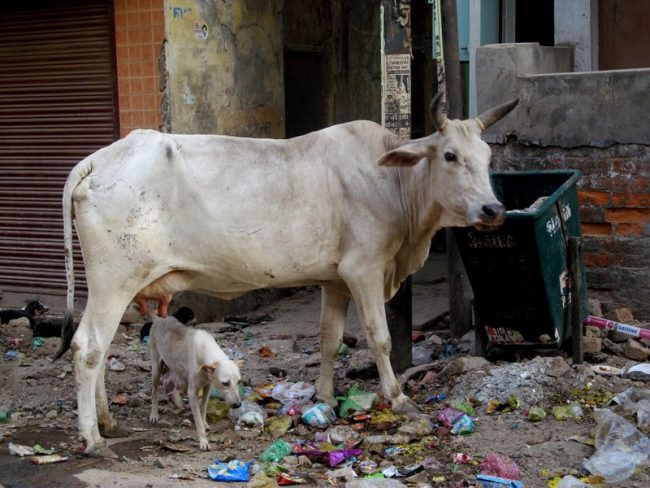
So, when in Delhi, head to the mosque, hire a pedal rickshaw and get ready for a fascinating, stimulating and eye-opening way to experience the complex layers and tough realities of India.
Author’s Bio: After a life-long profession of treating the mentally ill at a PA psychiatric hospital for 33 years and also serving as its Director of Admissions, Carol retired to Lake Chapala, Mexico in 2006 with her husband, to pursue more positive passions. Her family thought that she, too, had ‘gone mad.’ She’s been teaching English to Mexican adults for ten years, in a program operated by volunteer expatriates and writing for local on-line and print publications. Using her adventures experienced during visits to over 80 countries to capture a niche in travel writing, Carol also dabbles in ‘memoir.’ A frequent contributor to Lake Chapala English magazine, “El Ojo del Lago,” she’s won several literary awards from that publication, including Best Feature in 2010 and Best Fiction in 2014. She also netted a story regarding her psychiatric field work in the published anthology, “Tales from the Couch.”
- Together at Sea: A Mediterranean Family Adventure - April 27, 2024
- Travel Guide to Colorado - April 26, 2024
- Travel Guide to Croatia - April 26, 2024

This is the very informative information. Amazing Blog.
I found this article while surfing on Internet. It is Great to see that there is such information available. I will keep following all your posts and blogs. It is full of Travel world and informative.
Thanks for sharing your experience and photos with us, keep posting like this.